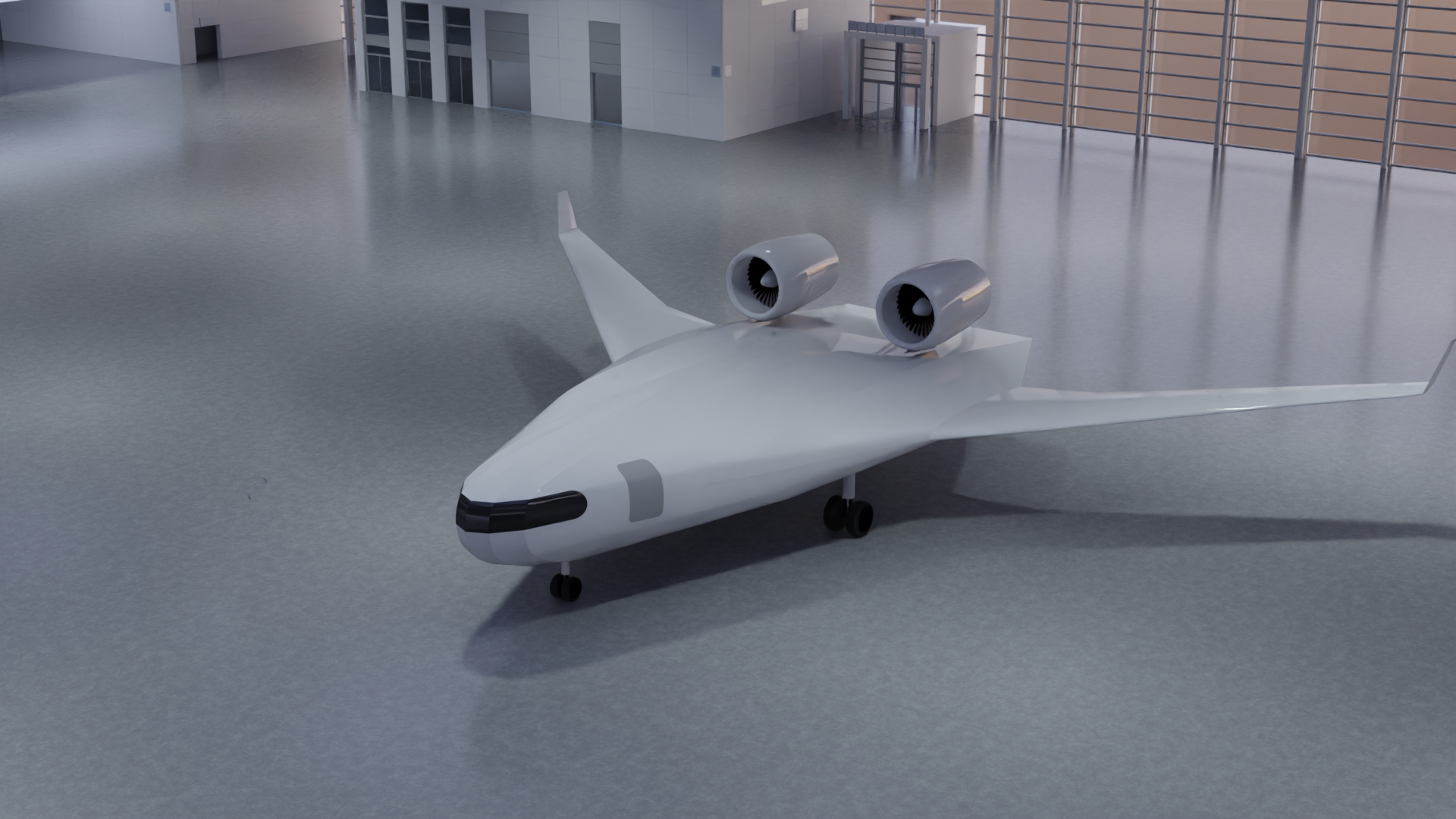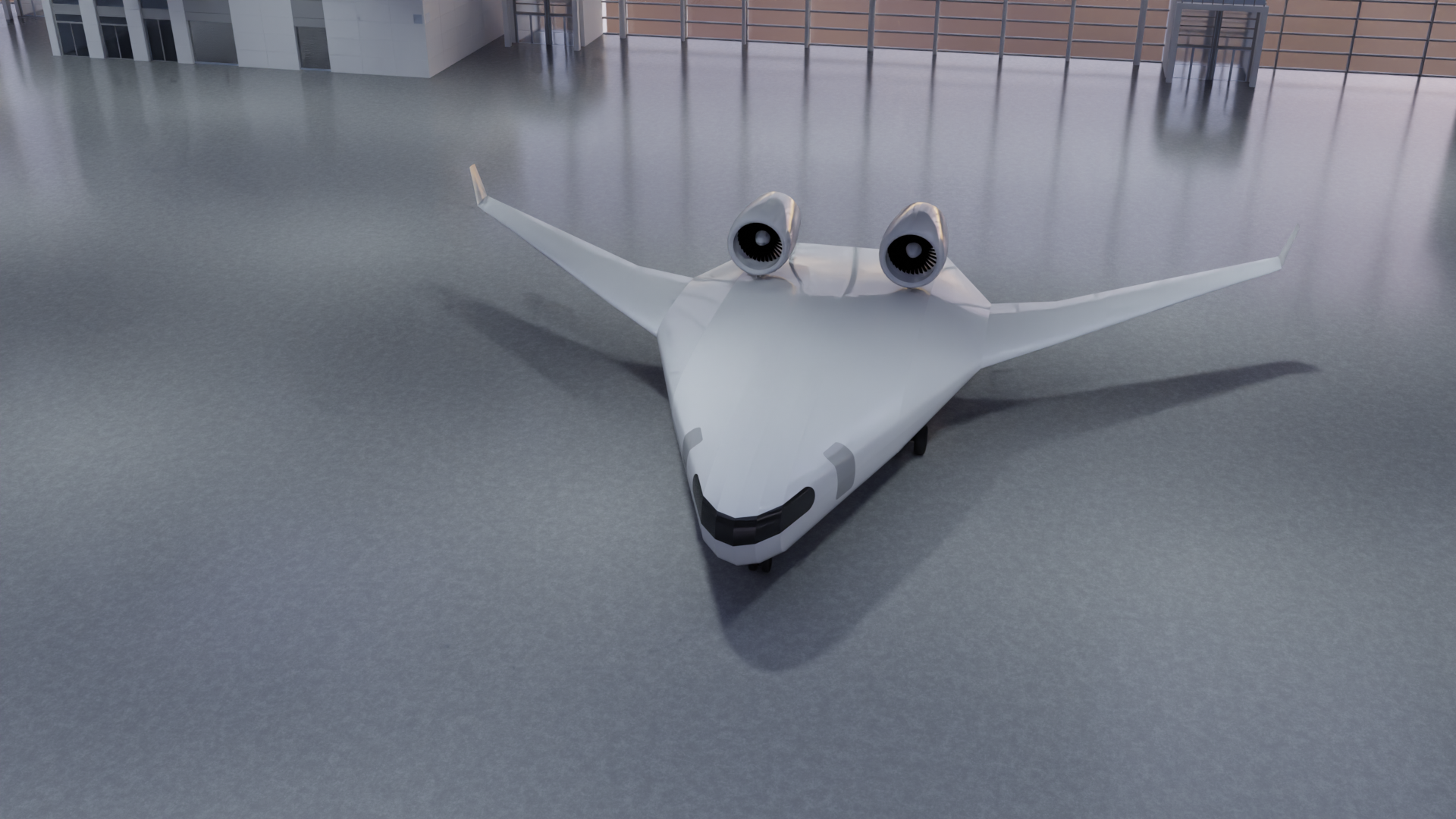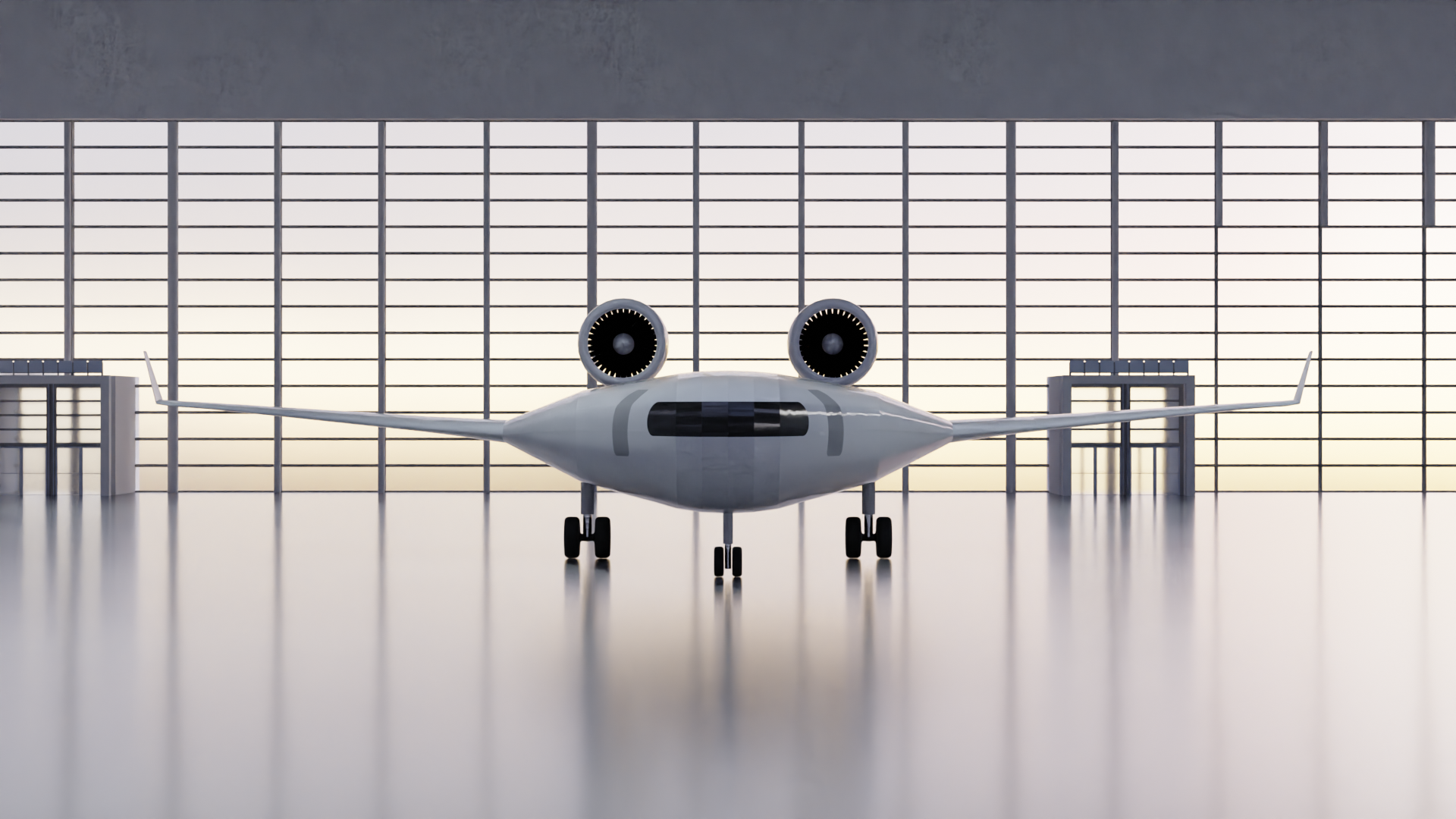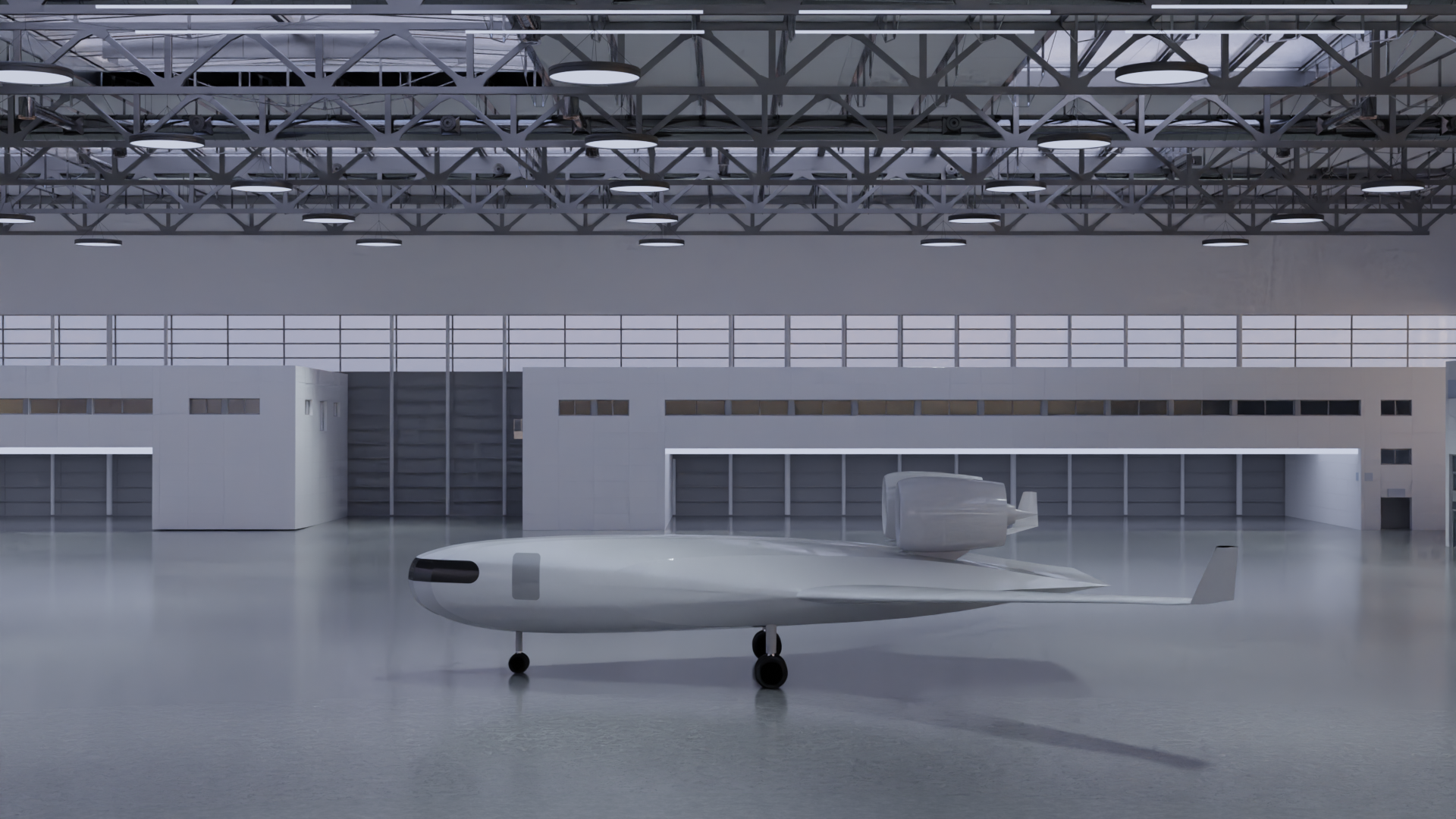With its distinctive design, the aircraft was developed as an alternative, highly aerodynamic, lightweight and therefore fuel efficient aircraft. The ultimate goal was to reduce the carbon footprint immensely. In this aircraft, the wing and fuselage appear to be “blended”. This means that the passengers will sit in the cabin, while the cargo bays, with the same capacity as conventional designs, will be located next to it. This concept has a wingspan of 36 metres to best meet the size restrictions of airport gates. With its relatively small size, it was quite unique at the time of its design.
These design features make the D150-BWB-2035 a research-driven exploration of alternative configurations for short-haul aviation.
The most important differences to today’s short-haul aircraft are listed below:
- Novel configuration of a blended wing body instead of tube and wing.
- Reduced engine noise compared to today’s aircraft as the aft engine is located on top of the centre body.
Advantages
-
⬆️ Well-known superior aerodynamic performance compared to a conventional tube and wing configuration and therefore very fuel efficient
-
⬆️ Combination of reflexed airfoils at the center body for pitch trim stability and supercritical airfoils at the outer wing to generate a near elliptic span wise lift distribution
-
⬆️ Reduced engine noise in comparison to today’s aircraft due the aft engine is placed on top of the center body
-
⬆️ Larger internal volume: the BWB offers increased payload capacity and flexibility in terms of interior configurations
Challenges
-
➡️ The longitudinal and lateral control of a BWB remains challenging but could be solved using advanced avionic systems and a well-designed movable layout
-
➡️ The number and location of emergency exits for embarking and disembarking of passengers remains challenging
-
➡️ It is a windowless cabin, yet passenger comfort has to be ensured
-
➡️ Detailed design issues, such as maintenance, airport compliance and operations, ditching, wing anti-icing
Project & Partners
The D150-BWB-2035 configuration was created in the NACOR project (
New innovative
Aircraft
COnfigurations and
Related issues, 2015-2022), in collaboration with the French aerospace lab ONERA, in the frame of the Clean Sky 2 Airframe ITD pillar. Clean Sky 2 is part of part of the European Commission's
Horizon 2020 Research and Innovation Programme.The project aim: identify the most promising short to medium range aircraft configuration among a plethora of conventional and unconventional air vehicle concepts, with the ultimate goal of significantly reducing carbon-footprint and fuel consumption in future aviation.
Outlook
Research is needed to address the detailed design and identify potential resulting challenges. Certification, windowless flying in relation to passenger comfort, emergency/exit plans and other aspects would need to be explored.
Key Characteristics
| Name |
Unit |
Value |
| Year of Entry Into Service (EIS) |
- |
2035 |
| Design Range |
NM |
2500 |
| Design Cruise Mach Number |
- |
0.78 |
| Design Mission Payload |
kg |
17000 |
| Initial Cruise Altitude |
ft |
3437 |
| Service Ceiling |
ft |
3995 |
| Takeoff Balanced Field Length (SL, ISA conditions) |
m |
1900 |
| Landing Field Length (SL, ISA conditions) |
m |
1741 |
| Approach Speed (Calibrated Airspeed) |
kts |
138 |
| Climb Speed (Calibrated Airspeed) |
kts |
280 |
| Descent Speed (Calibrated Airspeed) |
kts |
250 |
| Number of Passengers (Standard Layout) |
- |
150 |
| Max Payload |
kg |
20000 |
Mass Breakdown
Payload-Range Diagram
References
Increasing Fuel Efficiency for Short to Medium Range Market: A Conceptual Aircraft Design Study on Unconventional Configuration.
Fröhler, Benjamin, Iwanizki, Michael, Woehler, Sebastian and Zill, Thomas
AIAA Aviation Forum and ASCEND, 2024. AIAA Aviation Forum and ASCEND co-located Conference Proceedings, 2024-07-29 - 2024-08-02, Las Vegas, Nevada, USA.
Download
Recommended citation
Impact of the Number of Wing Stations on the Twist Distribution of a BWB Conceptual Aircraft Design in a MDAO Environment to Match Target Lift Distribution.
Fröhler, Benjamin and Iwanizki, Michael and Balack, Philip and Häßy, Jannik and Silberhorn, Daniel.
33rd Congress of the International Council of the Aeronautical Sciences, ICAS 2022. 33rd Congress of the International Council of the Aeronautical Sciences 2022, 2022-09-04 - 2022-09-09, Stockholm, Sweden.
Conceptual Design of a Blended-Wing-Body for a Short/Medium Range Mission Enhanced by High-Fidelity Aerodynamics.
Fröhler, Benjamin and Iwanizki, Michael and Zill, Thomas
Deutscher Luft- and Raumfahrtkongress 2021, 2021-08-31 - 2021-09-02, Bremen, Germany.
CONCEPTUAL DESIGN STUDIES OF UNCONVENTIONAL CONFIGURATIONS
Iwanizki, Michael and Wöhler, Sebastian and Fröhler, Benjamin and Zill, Thomas and Meheut, Michael and Defoort, Sebastien and Carini, Marco and Gauvrit-Ledogar, Julie and Liaboeuf, Romain and Tremolet, Arnault and Paluch, Bernard and Kanellopoulos, Stylianos
Aerospace Europe Conference 2020, 2020-02-25 - 2020-02-28, Bordeaux, Frankreich.





